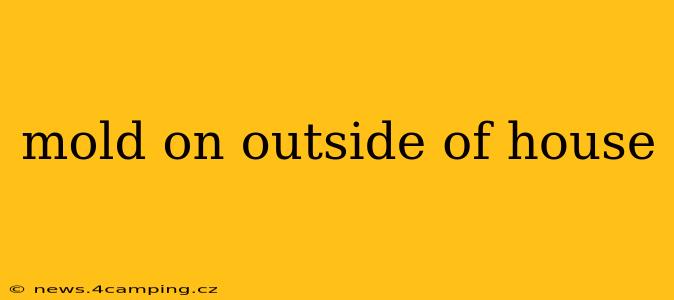Mold on the exterior of your house is an unsightly and potentially problematic issue. While not always indicative of a serious problem, it's crucial to understand its causes, identify the type of mold, and take appropriate action to prevent further growth and potential damage to your home's structure. This comprehensive guide will help you address mold growth on your house's exterior effectively.
What Causes Mold to Grow on the Outside of a House?
Mold thrives in damp, shady environments. Several factors can contribute to its growth on the exterior of your home:
- Moisture: This is the primary culprit. Rainwater, leaks, condensation, and high humidity levels provide the ideal environment for mold spores to germinate and flourish. Areas with poor drainage, damaged siding, or leaky gutters are particularly susceptible.
- Shade: Mold prefers dark, less sunny areas. Areas of your house that receive limited sunlight are more prone to mold growth.
- Organic Matter: Mold feeds on organic materials like wood, leaves, and decaying plant matter. Accumulation of these materials near your house's exterior provides a food source for mold.
- Lack of Air Circulation: Poor ventilation around your house prevents moisture from evaporating, creating a humid environment conducive to mold growth.
What Kinds of Mold Are Commonly Found on House Exteriors?
Several types of mold can grow on the outside of a house. Accurate identification is often difficult without laboratory analysis, but some common exterior molds include:
- Cladosporium: A very common type, often appearing as dark green or brown patches.
- Alternaria: Another prevalent type, appearing dark brown or black.
- Aureobasidium: Often black or brown, and can be found on painted surfaces.
Note: While many exterior molds are relatively harmless, some can cause allergic reactions or respiratory issues. If you suspect you have a serious mold infestation or experience health problems, it's crucial to contact a professional mold remediation specialist.
How to Prevent Mold Growth on the Outside of Your House?
Proactive measures are key to preventing exterior mold growth. Here are some effective strategies:
- Proper Drainage: Ensure your gutters and downspouts are clean and functioning correctly to divert rainwater away from your house's foundation. Improve drainage around your foundation by grading the soil to slope away from the house.
- Regular Cleaning: Clean your siding regularly with a pressure washer or a solution of mild detergent and water. Pay special attention to areas prone to mold growth.
- Trim Overhanging Branches: Keep tree branches and shrubs trimmed back from your house to improve air circulation and reduce shade.
- Repair Leaks Promptly: Address any leaks in your roof, windows, or siding as soon as possible to prevent moisture buildup.
- Improve Ventilation: Ensure adequate ventilation around your house to prevent moisture from accumulating.
How to Remove Mold from the Outside of Your House?
For small mold patches, you can often remove them yourself. For larger infestations or if you have concerns about your health, it's recommended to hire a professional mold remediation company.
For small areas:
- Safety First: Wear protective gear, including gloves, eye protection, and a respirator.
- Scrubbing: Use a stiff brush and a solution of bleach and water (1 part bleach to 10 parts water) to scrub the affected area. Caution: Bleach can damage some materials, so test it on an inconspicuous area first.
- Rinse: Thoroughly rinse the area with clean water after scrubbing.
- Dry: Allow the area to dry completely.
What if I Have a Large Mold Infestation on the Outside of My House?
If you have a large area affected by mold, or if the mold keeps returning despite your efforts, it's best to consult a professional mold remediation specialist. They have the expertise and equipment to properly assess and remediate the problem, ensuring the safety of your home and family.
Is Mold on the Outside of My House Dangerous?
While most exterior mold is not directly harmful, it can pose several risks:
- Allergic Reactions: Mold spores can trigger allergic reactions in sensitive individuals, leading to symptoms like sneezing, coughing, and itchy eyes.
- Respiratory Problems: In some cases, exposure to mold can worsen respiratory conditions like asthma.
- Structural Damage: Prolonged mold growth can damage your house's siding, wood, and other materials.
How Much Does Mold Removal Cost?
The cost of mold removal varies significantly depending on the size of the infestation, the type of mold, and the complexity of the remediation process. Small areas can be cleaned relatively inexpensively, while extensive infestations may require professional help and result in higher costs. Getting multiple quotes from reputable professionals is always recommended.
How Can I Prevent Mold Growth on Exterior Brick?
Mold growth on brick is common due to the porous nature of the material. Regular cleaning and proper drainage are crucial, as mentioned earlier. Consider using a mold-resistant sealant on your brick to further prevent growth.
This guide provides a starting point for addressing exterior mold. Remember, prevention is always the best approach. By regularly inspecting your home's exterior and taking appropriate preventative measures, you can significantly reduce the risk of mold growth and maintain the beauty and integrity of your property.
